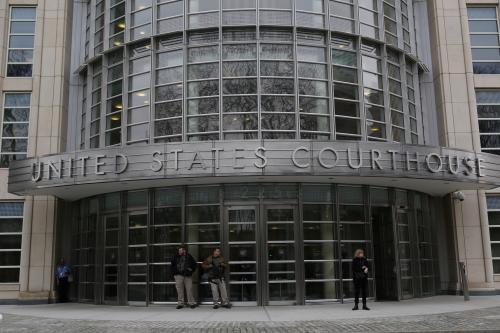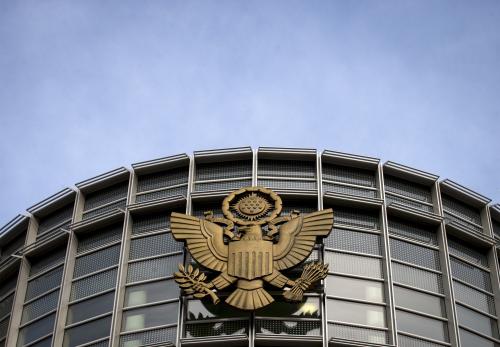On 12/6/16 this post was updated with the following: an additional vacancy just announced, and a correction to the projections to reduce Democratic appointees by two.
Speculation about changes to the Supreme Court has overshadowed discussion of the likely changes in the courts of appeals and district courts, where most federal judicial work gets done. President Trump will assume, as did President Bush, that he has a mandate to reshape the federal courts—popular vote loss notwithstanding. Filibuster-deprived Senate Democrats can be expected to exploit every tool at their disposal to stop controversial nominees, given that Republicans confirmed only a handful of Obama nominees once they took control of the Senate in 2015.
This post presents facts and speculation about current and potential judicial vacancies and how many might get filled. The data come primarily from the Federal Judicial Center’s biographical data base and my own data sets.
The bottom line: Democratic appointees now dominate the lower courts, and the majority of judges who are or will become eligible to take senior status or retire over the next four years (thus creating vacancies) are Republican appointees. Although Trump’s appointees will probably replace more Republican appointees than Democratic appointees, he may nonetheless be able to create modest Republican-appointee majorities among judges in active (full-time) status through 2020. I have laid out my assumptions; readers may wish to plug different assumptions into the factual scenarios.
Scholars have documented that party-of-appointing-president may help predict judicial decisions. It’s an important factor, even if the party-of-appointing-president breakdown among active status judges tells less than meets the eye. Most senior judges (those no longer in active status) participate in some cases. And, on the courts of appeals, randomly selected three-judge panels of active, senior, and visiting judges are unlikely to reflect the full court’s composition of active status judges.
Creating vacancies
Almost all district and circuit vacancies occur when judges leave active status to become senior judges. They can do so after they turn 65 and their age plus their years of service (including district court service for circuit judges) total 80—15 years at age 65, 14 at 66, and so on until ten years at 70, when the age part of the equation freezes. A few judges retire completely under the “rule of 80,” and, in either case, they keep their salaries.
Thus, knowing active-status judges’ eligibility to go senior (or retire, lumped together in this paper), and speculating on whether they will do so can give a rough picture of what vacancies may occur—recognizing as well that a few additional judges will resign before achieving an “80” score, die in active status, or get appointed to a higher court.
1. The District Courts
Except for further changes after November 17, 2016 2016 (including any lame-duck session confirmations), this will be the make-up of the district courts on Inauguration Day. The count of active status judges excludes, and the count of vacancies includes, now-active status judges who have formally announced a future date on which they will take senior status or retire (14 of the 96 below).
| Republican appointees (in active status) | 232 (34%) |
| Democratic appointees (in active status) | 345(51%) |
| Vacant—current & announced | 96 (14%) |
| Total district judgeships (set by statute) | 673 |
Filling current vacancies
Forty-eight of the 96 current and announced vacancies are in states that will have at least one Democratic senator in the 115th Senate. Senate Judiciary Committee leadership says it will continue not processing judicial nominations unless both home-state senators of either party return favorable “blue slips” approving a nominee. Home-state Democratic senators may hard bargain with the administration about nominees, as did Republican senators during the Obama administration, creating more and longer nominee-less vacancies.
Were the administration to submit nominees for 85 of the 95 vacancies, and if the filibuster-less Senate confirmed 83 of them, this would be the makeup of the district courts:
| With 83 vacancies filled | |
| Republican appointees | 315 (47%) |
| Democratic appointees | 345 (51%) |
| Vacant | 13 ( 2%) |
| Total district judgeships | 673 |
Prospective vacancies
(Note: These numbers are imprecise because of the difficulty of pinning down precise birthdates; I used July 1 of the birth year when I couldn’t find a birth date.)
About 102 active-status district judges—15 percent—are eligible to take senior status, and about 114 more will become eligible before May 31, 2020, when the nomination-confirmation process will largely shut down in the lead-up to the next presidential election. Of these 216 current and future senior-status eligible judges, 133 (61 percent) are Republican appointees.
How many of the eligible 216 will actually create vacancies? Some of the 102 now-eligible judges have been eligible for ten or more years, but most eligible judges do not linger long in active status. Looking to recent patterns, of the 554 current senior or retired judges, 266 became eligible for senior status when they turned 65, and 71 percent of them left active status within a year of turning 65; those who had to wait longer to reach an 80 score probably went senior even more quickly.
Assume conservatively that roughly 65 percent of the active-status judges who are or will become senior-eligible go senior or retire by mid-2020 and apply that 65 percent to the 133 eligible Republican-appointees and 83 eligible Democratic-appointees. That would create about 140 vacancies (compared to 135 and 136 district judges who went senior or retired in each of Obama’s two terms). Thus, we’d be left with:
| Impact of 140 judges’ assuming senior status* | |
| Republican appointees | 229 (34%) |
| Democratic appointees | 292 (43%) |
| Vacant | 153 (23%) |
| Total district judgeships | 673 |
*Of course, vacancy-creation and vacancy-filling will be a moving process. There won’t be over 150 vacancies at the same time.
Filling vacancies
How many of these roughly 150 vacancies would get filled? Thirty* states—including the judgeship-rich states of California, Illinois, Michigan, New York, Ohio, and Pennsylvania—will be represented by at least one Democratic senator, who, as noted, may bargain hard with the administration, as home-state Republican senators did during the Obama administration. (*Note: Previously, this figure was written as 28.)
Assume the administration is able to get home-state-senator agreement on 130 nominees, and assume that the Senate confirms 110 of them (which may be optimistic if the Senate is involved in more than one knock-down Supreme Court battle). Then the makeup of the district bench would look something like the right-hand column by mid-2020:
| Jan. 2017 | Mid-2020 | |
| Republican appointees | 232 (34%) | 339 (50%) |
| Democratic appointees | 345 (51%) | 292 (44%) |
| Vacant | 96 (14%) | 42 ( 6%) |
| Total district judgeships | 673 | 673 |
2. The Courts of Appeals
(These analyses track those above without duplicating in full the explanations, and also speculates about the make-up of each of the 13 courts of appeals.)
Except for changes after November 17, and including announced future vacancies as current vacancies:
On Inauguration Day:
| Republican appointees | 72 (40%) |
| Democratic appointees | 91 (51%) |
| Vacant—current & announced | 16 ( 9%) |
| Total circuit judgeships (set by statute) | 179 |
Filling current vacancies
Ten of the 16 vacancies are in states that will have at least one Democratic senator in the 115th Senate. If the administration were able to submit nominees for 14 vacancies, and the Senate confirmed 12 of them, the court of appeals aggregate make-up would be:
| With inauguration day vacancies filled | |
| Republican appointees | 84 (47%) |
| Democratic appointees | 91 (51%) |
| Vacant | 4 (2%) |
| Total circuit judgeships | 179 |
Filling prospective vacancies
Seventy-three active circuit judges are already eligible for senior status and 25 more will become eligible by mid-2020.
Almost three quarters of those now eligible have been so for ten years or more and would seem unlikely to take senior status willingly. Looking again to recent patterns, of the 128 once-active circuit judges who are now senior or retired, 84 became eligible for active status when they turned 65, and 67 percent of them left active status within a year of turning 65. For the purposes of this preliminary analysis—and noting the high number of active judges with long-standing senior-status eligibility—assume conservatively that roughly 30 percent of the 98 judges will go senior or retire. That may be too low an estimate if a sizable number of long-eligible Republican appointees have been waiting for a Republican president to appoint their successors. There are scholarly disagreements about how frequently judges leave active status for such reasons. Regardless, however, if more than 30 percent of eligible Republicans leave active status, their Trump-appointee replacements will not affect the party-of-appointing-president balance (but could affect ideological disposition and median age of the cohort).
A 30 percent senior rate applied to the 51 eligible and future-eligible Republican appointees and 47 such Democratic appointees would create roughly 29 circuit vacancies to fill, compared to 28 and 23 circuit judges who took senior status or retired during Obama’s two terms.
| If 29 take senior status | |
| Republican appointees | 69 (38%) |
| Democratic appointees | 77 (43%) |
| Vacant | 33 (19%) |
| Total circuit judgeships | 179 |
Assume that the administration submits nominations for 28 of the 33 vacancies and the filibuster-less Senate confirms 25 nominees. Then the makeup of the appellate bench would look something like the right-hand column by mid-2020:
| Jan. 2017 | Mid-2020 | |
| Republican appointees | 72 (40%) | 94 (52%) |
| Democratic appointees | 91 (51%) | 77 (43%) |
| Vacant | 16 ( 9%) | 8 (5%) |
| Total circuit judgeships | 179 | 179 |
Possible changes in the composition of each court of appeals
Democratic appointees have majorities on nine courts of appeals, and supermajorities (twice as many or more) on five. Republican-appointees have supermajorities on four.
| R-appts | D-appts | Vacant | Total | |
| 1st | 2 | 4 | 0 | 6 |
| 2nd | 4 | 7 | 2 | 13 |
| 3rd | 5 | 7 | 2 | 14 |
| 4th | 5 | 10 | 0 | 15 |
| 5th | 9 | 5 | 3 | 17 |
| 6th | 10 | 5 | 1 | 16 |
| 7th | 6 | 3 | 2 | 11 |
| 8th | 7 | 3 | 1 | 11 |
| 9th | 7 | 18 | 4 | 29 |
| 10th | 5 | 7 | 0 | 12 |
| 11th | 3 | 8 | 1 | 12 |
| DC | 4 | 7 | 0 | 11 |
| FED | 4 | 8 | 0 | 12 |
| 71 | 92 | 16 | 179 |
Even the administration’s filling all 16 vacancies in place (or announced) on Inauguration Day would not change the breakdown greatly, as shown in the table below. Democratic appointees would have majorities on one fewer court, that in the Third Circuit, which would have an even breakdown. Democratic appointees would still have five courts with supermajorities, and Republican appointees would still have four.
Guessing—for each court—how many more judges might leave active status and how many nominees might get submitted and then confirmed is impractical. The table’s second-to-right-hand column, however, shows, by court, the number of active judges who are senior-status eligible now or will be by 2020. The right hand column shows the number of those judges who are Democratic appointees.
| After filling the 16 current vacancies | Senior-eligible circuit judges by mid 2020 | ||||||
| Rep App | Dem App | Vacant | Total | Sen Elig | D-appts only | ||
| 1st | 2 | 4 | 0 | 6 | 2 | 1 | |
| 2nd | 6 | 7 | 0 | 13 | 8 | 5 | |
| 3rd | 7 | 7 | 0 | 14 | 5 | 3 | |
| 4th | 5 | 10 | 0 | 15 | 9 | 5 | |
| 5th | 12 | 5 | 0 | 17 | 9 | 2 | |
| 6th | 11 | 5 | 0 | 16 | 11 | 4 | |
| 7th | 8 | 3 | 0 | 11 | 7 | 2 | |
| 8th | 8 | 3 | 0 | 11 | 6 | 2 | |
| 9th | 11 | 18 | 0 | 29 | 19 | 12 | |
| 10th | 5 | 7 | 0 | 12 | 6 | 2 | |
| 11th | 4 | 8 | 0 | 12 | 6 | 4 | |
| DC | 4 | 7 | 0 | 11 | 4 | 3 | |
| FED | 4 | 8 | 0 | 12 | 6 | 3 | |
| 87 | 92 | 0 | 179 | 98 | 48 | ||
If Trump replaced all 48 eligible Democratic appointees, every court of appeals would become a Republican-appointee majority court. That’s not going to happen, but plenty will be watching what does. At the least, some closely divided courts seem poised to shift, from Democratic-appointee majorities to Republican-appointee majorities, and from narrow Republican-appointee majorities to more robust such majorities.
Author’s Note: Thanks to Federal Judicial Center Associate Historian Jake Kobrick for reviewing the numbers in this post and suggesting some corrections. I am solely responsible for any remaining errors and for the analysis.
The Brookings Institution is committed to quality, independence, and impact.
We are supported by a diverse array of funders. In line with our values and policies, each Brookings publication represents the sole views of its author(s).








Commentary
How Trump could reshape the lower federal courts
November 17, 2016